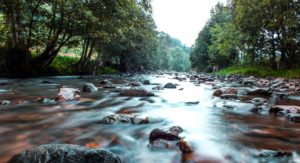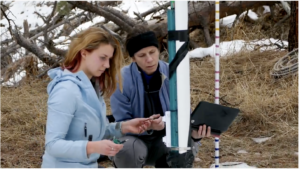
When you’re hiking along a mountain trail and reach a small stream small enough to hop over, the name you use to describe it may not seem overly important. Yet recently, a federal rule change means the terms used to describe flow duration of streams determines whether or not they are protected under the Clean Water Act.
In Jan. 2020, the United States Environmental Protection Agency and Army Corps of Engineers released the Navigable Waters Protection Rule. This replaced the Obama-era Clean Water Rule, which clarified what the Clean Water Act broadly describes as Waters of the United States (WOTUS). Now, ephemeral streams, which only flow briefly after rain or rapid snowmelt, are not included in the definition of WOTUS, meaning these streams are no longer protected under the Clean Water Act.
A research group led by Dr. Stephanie Kampf with the National Resource Ecology Laboratory has been working for the last 4 years to map and define small headwater streams. Kampf, a professor in the Department of Ecosystem Science and Sustainability, said that flow data on these small streams in the foothills of Colorado often does not exist.

“When we started working on streamflow forecasting for the Cache la Poudre over a decade ago, we realized that all of the snow measurements were at the highest elevations in the river basin, whereas the river flow measurements were at the lowest elevations,” Kampf said. “This left a large gap in the middle of the basin with limited observations.”
That is why Kampf and her team have been working to create a detailed record of this streamflow in as many places as possible. In Colorado, Kampf said most of these small streams will retain their protections because they are either intermittent and flow seasonally, or they’re perennial and flow year-round. But in places like Arizona and New Mexico where ephemeral streams are abundant, the rule change removes requirements that protect or mitigate actions to these streams.
“These streams are no longer protected, so a pollutant could be left in a dry wash and transported downstream during a rainstorm,” Kampf said.
Kampf explained that if data reveals that streams currently mapped as ephemeral, “sometimes called washes or arroyos,” are actually intermittent, then this could inform a decision by the EPA and USACE to classify a stream as a WOTUS under the Clean Water Act.
The Power of the Crowd
The team has stations along the Poudre River where they routinely visit to collect data and make observations. But with more streams to track than the team can cover themselves, they’ve decided to enlist the help of a cutting-edge tool: the crowd.
Kira Puntenney-Desmond is the project manager for Stream Tracker, a citizen-science fueled mobile-application that encourages anyone exploring the outdoors, anywhere in the country, to submit data on the small streams they come across.
Inspired by the popular mobile app Pokemon Go, Puntenney-Desmond decided to tap into the vast population of smartphone users to assist with data collection.
So far, the app has amassed 5000 observations from 540 volunteers across 32 states. Crowdsourcing has significantly accelerated the amount of data the team has to work with, painting a larger, more accurate picture of when and where water is flowing. And with the new EPA rule changes in place, if there has ever been a time to understand the flow of these streams, it’s now.
“Through Stream Tracker and other efforts that expand stream monitoring, we hope to develop tools that can reliably predict where streams are located and what type of flow they have,” Kampf said.
To join the effort, download the app Anecdata to join the Stream Tracker project and many other citizen-science based research projects. Then, the next time you pass a waterway, dry or flowing, you’ll be able to contribute to a growing database of knowledge.
“One to hundreds of people might follow in your footsteps past that same exact point,” Puntenney-Desmond said. “And then you start creating a record of that change over time … it’s the power of the crowd.”